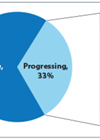
Back in 1993, the late and great Barry Cullen FRCS (Cavan born, Dublin trained), the first editor of Eye News, asked me to write an article about the current treatment of chronic open angle glaucoma (COAG). At the time I had been a consultant colleague of Barry’s in the Royal Infirmary of Edinburgh for a mere 12 months. I had two glaucoma fellowships under my belt – a clinical research fellowship with Bernie Schwartz in Boston (optic disk imaging and perimetry) and a surgical fellowship with Roger Hitchings at Moorfields Eye Hospital, London. I gave my view of where current clinical management was at the time, and talked about research and how new discoveries in the lab might filter through to future glaucoma care.
So, when Eye News’ current editorial coordinator, Samuel Verdin, asked me to do a follow-up ‘commentary’ to reflect on 30 years as a glaucoma specialist, I said of course, why not? Re-reading what I wrote all those years ago as I was just embarking on my consultant journey made me smile. To a large extent, I nodded in agreement with much that I had written. My first thought was that everything had changed since then, but then again, has it changed much? What really has changed in day-to-day glaucoma care, either from the doctor’s perspective or from the patient's viewpoint, over the last 30 years?

I started my fellowship training in Boston at a time when the world of practising glaucoma specialists in the US had just been rocked by a publication from Eddy and Billings, The Quality of Medical Evidence: Implications for Quality of Care (1987).
In that paper, they highlighted the fact that there was no evidence that glaucoma treatment actually worked. These public health policy experts were recommending that Medicare and the health insurance companies should consider NOT paying for the costs involved in glaucoma care, along with other targeted medical conditions, in the US!
The lack of scientific evidence was simply this: there had never been, to that point in time, any large-scale prospective randomised controlled clinical trials of treatment versus no treatment in glaucoma – proof was lacking that treatment worked. In 1988, a paper by Holmin and Krakau reported a very small, failed trial of only 15 patients, enrolled in a treatment versus no treatment trial. The authors queried the feasibility of ever doing such a trial in the future.
This rather alarming crisis prompted the National Eye Institute at the National Institutes of Health (NIH), at a cost of over $100,000,000, to largely underwrite several large-scale studies (called the “alphabet soup” of trials with a control untreated group, including EMGT, CNTGS, OHTS) which thankfully proved beyond doubt that treatment of glaucoma and ocular hypertension was indeed effective, but it took until the mid-to-late 1990s to get these outcomes. We finally had the evidence that IOP lowering works. These trials subsequently became the backbone of numerous publications about glaucoma clinical guidelines produced by the European Glaucoma Society, the American Academy of Ophthalmology and numerous other groups. These highlighted the essential role of evidence-based medicine (EBM) that all clinicians should rightfully keep in mind when recommending treatment, especially any new treatment to patients.
I'm going to confine all my comments in this article to the management of COAG in the so-called ‘developed’ parts of the world, though I would like to give a particularly strong shout-out for the fantastic work done by people striving to improve glaucoma care in poorer countries. In particular, I refer to the work of Ian Murdoch MBE for his contribution to glaucoma care in Africa.
So, what’s changed and what’s new?
We now have different ways of monitoring patients which now can be done virtually, at home or in the community, especially for low-risk patients. This era of shared care (with orthoptists, optometrists, ophthalmologists and nurses) using new instruments for measuring IOP, even at home by patients, has begun. Indeed, it's very likely that we will also see the use of home perimetry become part of standard care in the future. The Covid-19 pandemic has accelerated this change.
My first exposure to the potential use of an electronic patient record (EPR) system was at the American Academy of Ophthalmology held in New Orleans in 1989, nearly 35 years ago. I really thought at that time that this was going to make the biggest difference ever in glaucoma care but sadly it’s taken many years and many trials and tribulations to get easy-to-use EPR systems that can incorporate perimetry and imaging into routine clinical care. It’s taken a lot longer than I anticipated to get to this point.
Having said that, one technological development which has accelerated incredibly fast is machine learning (AI), which will help us enormously with diagnostic assessment and also in monitoring not just for IOP but also for imaging and perimetry. AI has also been advocated to help us plan prospective randomised clinical trials in the future.
We also have the genome wide association studies (GWAS) that have identified over 130 glaucoma-related genes, though the causative effect of each of these genes is of low impact. Furthermore, the recent application of polygenic risk scores (PRS) – based on the GWAS data – appears to be able to identify patients at high risk of developing glaucoma due to elevated pressure, and also to identify patients at higher risk of developing progressive visual field loss. Therefore, PRS will undoubtably help us to target those who need earlier and more aggressive treatment in the future.
Other advancements and changes of note are:
- Ocular coherence tomography of the optic nerve and retinal nerve fibre layer has become part of routine clinical care.
- Measuring central corneal thickness at baseline (and possibly hysteresis) is essential.
- Low blood pressure / ocular perfusion pressure is a recognised (though largely an unmodifiable) risk factor.
- Improved patient education, and greater patient involvement in decision making.
- ‘Selective’ laser trabeculoplasty has almost become the ‘go-to’ initial therapeutic option in newly diagnosed patients.
- We are much better informed about quality-of-life issues that affect daily activities in our patients.
- The collagen-elastin cross-linking enzyme gene, LOXL1, is mutated in virtually all patients with pseudo-exfoliation glaucoma.
- We have the -omics revolution of translational research (gene / protein / phospho-protein / metabolomic) plus the additional application of systems biology to help us understand the disease mechanisms in greater depth.
The big winners and the big losers in this time period
In my opinion the single biggest contribution to improved patient care in the past 30 years has been the development of the prostaglandin analogues. I remember the excitement when the early trial data was presented at ARVO and the American Academy about these new drugs which were to be used once a day with very few side effects. They were launched onto the market in the mid-to-late 1990s and have contributed enormously to better care, good IOP control and more importantly, to better outcomes in terms of visual fields for patients worldwide. The more recent development of preservative-free eyedrops has also had a significant and very beneficial effect. Sadly, we have seen very few new glaucoma eyedrops come to the market in recent years, with the exception of the Rho-kinase inhibitors, and there is a need to address this issue urgently.
Perhaps the single biggest disappointment was the failure of the glutamate antagonist memantine to show benefit in phase 3 clinical trials. The field of glaucoma had been excitedly waiting for a neuroprotective agent based upon the fact that laboratory research had identified glutamate as a toxic compound for retinal ganglion cells (RGC) and memantine, which had been approved for clinical use for Alzheimer's disease and was subsequently trialled. Sadly, it failed by the mid-to-late 2000s to identify a positive benefit for patient care. This very costly failure almost led to the complete disappearance of the phrase ‘neuro-protection’ from the glaucoma lexicon.

Surgical developments
Augmented trabeculectomy remains the gold standard to achieve low IOP in eyes requiring good control; while new external tubes (e.g. Paul) appear promising. It’s rather hard to believe that we are still routinely using rather toxic compounds like 5-FU and MMC to prevent postoperative conjunctival fibrosis following glaucoma surgery! This area needs urgent attention.
The past 10 years has seen an exponential rise in new surgical devices, largely driven by industry, with much of this appearing on a variety of social media platforms uploaded by a younger generation of glaucoma ‘influencers’. There are two main types of innovations: angle surgeries and bleb-forming devices. My impression is that many of these angle surgeries and devices are ‘add-ons’ with phaco surgery. Angle surgeries and devices shouldn’t be considered a definite treatment in people with uncontrolled, severe disease who require a substantial reduction in IOP. Devices do not undergo the same rigorous assessment as medicines before being launched onto the market, (though this situation is changing).
An audit of a very large cataract database in Sweden has shown an average IOP fall of 1.5mmHg in normal eyes (mechanisms unclear), and this IOP fall can be as large as 7mmHg or more in many glaucoma eyes, especially in pseudo-exfoliation glaucoma and those with narrow drainage angles. A Cochrane meta-analysis largely failed to show a benefit of using these devices over phaco alone. This begs the question about how to get informed consent from patients preoperatively going for cataract surgery who may also have glaucoma. It’s not that I am against innovation but we need to have more of an evidence-based approach to the introduction of these new devices in the best interests of our patients.
Loss of vision and glaucoma blindness
The single biggest risk factor for blindness in glaucoma has repeatedly been shown to be late presentation and late diagnosis. This is especially true in socially deprived communities. Despite knowing this all-important factor, what has been done to address this problem of late presentation? The disappointing answer to that key question is: very little. Screening for glaucoma is not viewed as a ‘sexy’ topic for researchers. We do know that annual screening for glaucoma is not a cost-effective public health measure.
“In my opinion the single biggest contribution to improved patient care in the past 30 years has been the development of the prostaglandin analogues”
An important development in this arena was the publication last year by the Malmo group showing that the mean ‘preclinical detectable phase’ was 10 years using two different methods of analysis. The take-home message from that retrospective analysis indicated that screening with reasonably long intervals, e.g. every five years, might well be a more cost-effective approach to earlier detection of glaucoma in the community. Economic modelling from Anja Tuulonen’s group in Finland showed that screening may be cost effective. Higher-risk patient cohorts such as those with a family history should probably get screening on an annual basis. Perhaps the application of polygenic risk scores will also help to identify high-risk individuals in the community who might require more intensive screening than every five years. It’s safe to say that earlier detection and therefore treatment earlier in the disease process will make the single biggest difference to glaucoma blindness worldwide in years to come.
Prospects for the optic nerve
We now have a significant body of evidence to show that mitochondrial dysfunction in RGCs leads to a reduction in ATP energy production, and the cell’s ability to withstand stress. A number of prospective clinical trials (of nicotinamide / vitamin B3) have commenced to study the benefits of improved cellular bioenergetics at preventing progressive visual loss. Secondly, despite the very best efforts of research groups in recent years we’re still not in a position to regenerate the damaged optic nerve in glaucoma, though this certainly remains the holy grail in the future – the challenge is quite enormous.
Prospects for gene therapy
Undoubtedly, glaucoma is strongly inherited in a small number of families, usually presenting at a ‘young’ age, but this is uncommon in the general glaucoma population. Wherein my clinical experience, the majority of my adult patients deny knowing an affected family member, despite the claim that it’s one of the ‘most heritable’ of all diseases. There was a palpable wave of enthusiasm for the potential of gene therapy following the publication in Science in the 1990s that a mutation in the myocilin gene was causative in a sub-type of glaucoma. However, apart from a CRISPR-based paper in 2017 showing therapeutic benefit for one of the many myocilin mutations, there is little else in the literature that augurs well for future gene therapy for adult-onset glaucoma.
The next 30 years...
I would like to see fewer false positive referrals (the so-called ‘red disease’), perhaps using referral refinement pathways. I would also like to see larger OCT databases which control for the large variation in optic disc area and in refractive errors, particularly myopia. We also urgently need new medicines (of longer duration), better perimetric techniques to measure visual field progression, and better EPR systems. I think there's a definite place for non-hospital-based monitoring of stable and low-risk disease. I am certain that the integration of PRS, AI and targeted screening will considerably improve future care of our glaucoma patients.
The number of glaucoma-related publications has increased dramatically in the past 30 years. In 1993, there were over 22,000 glaucoma papers published on Pubmed. This number had risen to over 84,000 by the middle of 2023. Clearly, we know an awful lot more about glaucoma now than we did 30 years ago, but we need to be mindful that not all this research is contributing to improved patient care. While much of this cutting-edge research is telling us ‘more and more’ about ‘less and less’ (including my own contributions), we need to keep in mind a rather insightful recent comment by the head of UK Research and Innovation, Dame Ottoline Leyser, who noted that “if everyone breaks new ground and nobody builds, then all you get is lots of holes in the ground.”
Those of us of a certain vintage (i.e. the pre-social media cohort) greatly valued influential key opinion leaders for their wise counsel based on their experience of caring for glaucoma patients over many years. Perhaps the best example of this type of leader would be George Spaeth, now in his 92nd year, who provided mature and balanced commentary on changing trends in glaucoma management for over 50 years of his working life and thereafter. George must surely be laughing to himself to see his name on the 2023 Power List.
An old French Proverb goes, “Plus ca change, plus c’est la meme chose" (the more things change, the more things stay the same). Much has changed in glaucoma care over the past 30 years, but the key fundamental doctor-patient relationship is still at the heart of good care (this sine qua non was championed by George), especially in a long-term chronic disease like glaucoma. Evidence-based medicine (a term coined by Guyatt and Sackett in 1991 to describe how to use research evidence in clinical decision making, and secondly how to avoid using selective and biased evidence) has given us the guidelines for managing and monitoring of glaucoma patients in our clinics.
So, for all those 30-year-old trainees still reading this piece – stick with the evidence, the wisdom comes later. The only validation that counts in your career should come from your patients, not from internet clicks.
The author gives thanks to Yvonne Delaney for ‘steering’ these reflections, and to Augusto Azauro-Blanco for his proofreading expertise.
COMMENTS ARE WELCOME








